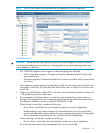
Virtual disks
HP P6000/EVA storage systems use a form of virtualization called virtual disks (vdisks) to store
data. Host computers see virtual disks as real storage objects, exactly as they would see physical
disks with the same characteristics.
Newly installed HP EVA storage systems are not pre-configured with virtual disks. After you initialize
the storage system and create disk groups, you can create virtual disks in the sizes and Vraid types
that you need. The storage system automatically determines where data is actually stored on the
physical disks. You do not need to have knowledge of individual physical disks in the storage
system.
In HP P6000 Command View 9.3 or later, when a LUN is provisioned with Vraid0 redundancy,
the HP P6000 Command View GUI displays an R0 icon on the LUN. If you select Vraid0 when
creating a LUN HP P6000 Command View displays a confirmation window to verify that redundancy
is not required.
Working with virtual disks in HP P6000 Command View
The virtual disks folder for an HP P6000/EVA storage system displays all virtual disks, regardless
of type. You can further organize virtual disks into subfolders that you create and name. You can
also move virtual disks from one subfolder to another.
(only a portion of the display is shown)
In the various virtual disk pages you can view virtual disk information, operational status, and
perform actions. For example, you can view general information, operational status, presentation,
and data replication (DR group) membership. You can also perform actions such as replicating
the virtual disk (creating snapclones, snapshots and mirrorclones) or migrating the disk group or
Vraid of a virtual disk.
30 Provisioning storage


















